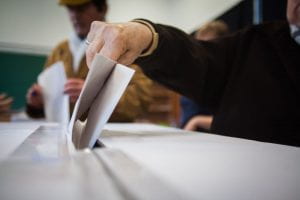Allegations of voter fraud date back over a century in the United States. You may have heard stories about a local community sending an absentee ballot to someone who is deceased, or a person trying to vote twice. As the 2020 election approaches, President Donald Trump – like many elected officials before him – is again calling into question the validity of voting in the U.S.
But what does scholarly research tell us about U.S. voter fraud? It turns out, there is quite a sizeable body of evidence on voter fraud over the past two decades. The vast majority of studies have concluded that voter fraud is too rare to influence national elections.
Take, for example, this study of double voting in the 2012 election. Researchers from Stanford, Harvard and Yale universities investigated how often a person with the same first name, last name and birthdate voted in more than one location. The authors used a model to estimate how many people in the U.S. are share the same name and birthdate. They used that model to estimate how many people in the U.S. have voted twice in the same election. Assuming there were no errors in voter registration records, their analysis found that at most 0.02 percent of the votes cast in 2012 were double votes. But they noted that many, if not all, of these apparent double votes could be a result of measurement error in their model. They also found that a cross-checking strategy designed to purge duplicate voters would eliminate 300 legitimate registrations (where two distinct people had the same name and birthdate) for every registration used to cast a double vote.
A separate systematic review by a political science professor at Brennan Center for Justice at New York University School of Law meticulously investigated voter fraud. (It is important to note that he defines voter fraud as a voter casting a ballot even though he or she is ineligible. This is different from accidental errors by voters or election officials or intentional misconduct by an election official or candidate.)
The review looks at specific allegations of voter fraud – typically identified in newspaper stories – and then follows up to find out if there were actual instances of fraud. In the all of the cases, the author finds the fraud is much smaller than originally believed or the result of a clerical or technical error. For example, in 2005, a Michigan newspaper article announced that 132 votes were alleged to have been cast by deceased voters because election officials did not properly match death records and voting lists. The Michigan Secretary of State launched an investigation and found that the “dead voters” actually used absentee ballots. Of the 132 problematic votes, 97 of the ballots were never cast and 27 people voted by absentee ballot before they passed away. Assuming the remaining 8 ballots were actual fraud (which the investigation was not able to prove) indicates that 0.0027 percent of votes in this specific election were fraudulent – not enough to make a difference in the result.
In a related column published in the Washington Post, this same author lists every instance of alleged voter fraud that he is able to find across the country and follows up to find out if there were actual fraudulent votes cast. Between 2000 and 2014, he found 31 instances of voter fraud in total the U.S. in any election – general, primary, special or municipal elections. Over that same period, in general and primary elections alone, U.S. voters cast more than 1 billion votes – leading to a miniscule rate of voter fraud.
Another study published in the journal American Politics Research uses a new method – identifying what the authors call “orphan votes” and “low-propensity votes” – to identify potentially fraudulent votes. Essentially, the authors are comparing lists of people who have voted between different elections, some low-profile and some high-profile, to identify votes that may have been cast fraudulently. Using this method to investigate allegations of voter fraud in specific municipalities across the country, they are not able to find any evidence of widespread voter fraud, even in locations where is fraud is suspected to be rampant.
A final review article written by a Columbia University political science professor in 2007 examined dozens of elections to quantify how often a voter casts a fraudulent ballot by impersonating another voter. The author found, on average, impersonation rates between 0.0003 percent and 0.0025 percent. Most allegations of voter fraud turned out to be related to clerical errors, poor data-matching practices, and voter error.
The take-home message: While allegations of voter fraud are frequently bantered around in the news media and by candidates, a large body of research demonstrates very little evidence of voter fraud – and clearly not enough to influence the outcome of an election.
Visit Cornell University’s Bronfenbrenner Center for Translational Research’s website for more information on our work.




Speak Your Mind